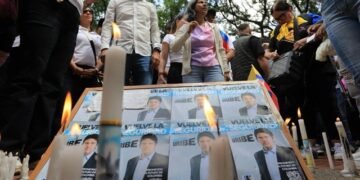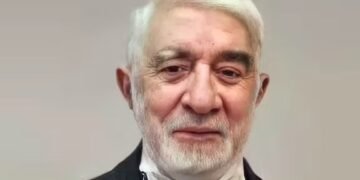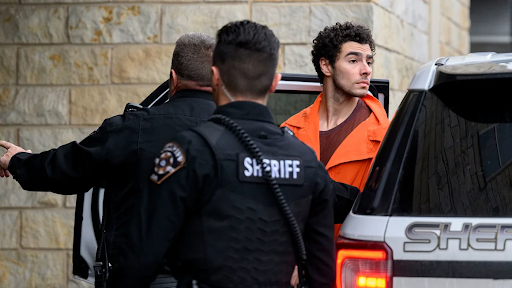The most serious charge against Luigi Mangione, the suspect accused of killing UnitedHealthcare CEO Brian Thompson in broad daylight on a Manhattan sidewalk, is second-degree murder. However, legal experts note that the charge could be upgraded to first-degree murder if prosecutors uncover evidence that he intended to commit terrorism by targeting other corporate executives.
Authorities say mounting evidence links the 26-year-old suspect to the December 4 assassination. According to NYPD Commissioner Jessica Tisch, a 3D-printed gun and a fake ID found on Mangione at his arrest in Pennsylvania match the shell casings discovered at the crime scene. His fingerprints also align with prints found on items near the area. Additionally, Mangione was carrying a document described as a “manifesto” that, while not containing direct threats, expressed “ill will towards corporate America,” according to NYPD Chief of Detectives Joseph Kenny.
Mangione has been charged with five counts, including second-degree murder, in New York. He also faces firearms charges in Pennsylvania related to the weapon found during his arrest. On Tuesday, he was denied bail and is fighting extradition to New York.
Under New York law, a first-degree murder charge applies only under specific aggravating circumstances, such as when the victim is a police officer, judge, or first responder, or when terrorism or murder-for-hire is involved. Legal analyst David Shapiro from the John Jay College of Criminal Justice explains that Mangione could face first-degree charges if investigators find evidence he planned to commit terrorism, such as targeting additional executives.
If convicted of second-degree murder, Mangione faces a sentence of 15 years to life. A first-degree conviction carries a harsher minimum sentence of 20 years to life.
Evidence and the Potential for Terrorism Charges
The NYPD’s intelligence report suggests that Mangione’s actions may have been fueled by resentment towards the health insurance industry and corporate greed. His manifesto and social media posts, reviewed by investigators, indicate he viewed Thompson’s assassination as a symbolic act against perceived corruption.
Shapiro noted that Mangione’s possession of the weapon, fake ID, and manifesto could suggest plans for additional attacks. “Why carry incriminating evidence unless you plan to use it again?” he questioned.
First-degree murder based on terrorism requires proof that the suspect intended to intimidate civilians or influence government policy. Shapiro added that fear among other insurance executives over potential copycat crimes strengthens the argument that terrorism may have been a motivating factor.
Why Mangione is Charged with Second-Degree Murder
New York’s criminal laws, rooted in the Model Penal Code, assess guilt based on states of mind—purposeful, knowing, reckless, or negligent. Premeditation, often associated with first-degree murder, has been largely replaced by this framework.
A second-degree murder charge offers an “affirmative defense,” allowing the defendant to argue for reduced charges, such as manslaughter, based on mitigating circumstances. Shapiro noted that Mangione’s case might evolve as investigators uncover more evidence, including possible discussions or social media activity suggesting a broader plan.
Federal Prosecution and Additional Charges
Mangione’s case could potentially move to federal court if evidence suggests he crossed state lines to commit violence, a federal crime carrying severe penalties, including life imprisonment or the death penalty. However, federal prosecutors must weigh whether such charges are necessary given the existing state-level prosecution.
Fighting Extradition
Mangione’s refusal to waive extradition is unusual but strategic. A Pennsylvania court has granted him 14 days to file a writ of habeas corpus, requiring authorities to justify his detention. Pennsylvania prosecutors have 30 days to obtain a governor’s warrant to authorize his transfer, a process that New York Governor Kathy Hochul has pledged to expedite.
Legal experts suggest Mangione may be fighting extradition to delay proceedings, scrutinize the evidence against him, or secure bail in Pennsylvania—a highly unlikely outcome given the severity of the charges.
What’s Next?
Once extradited to New York, Mangione will be arraigned and enter a plea, after which prosecutors will present evidence and begin discovery. NYPD investigators plan to compile a comprehensive timeline of the crime, including forensic and video evidence, to present a clear case to the jury.
Ken Corey, former NYPD Chief of Department, emphasized the importance of building an airtight case. “The goal is to create almost a movie of his movements to prove conclusively that he committed this crime,” he said.
While most defendants waive extradition to avoid prolonged detention in another state, Mangione’s approach reflects the high stakes of this case. Legal analyst Karen Agnifilo remarked, “In cases like this, there’s no chance of being released, so he’s fighting extradition.”
The next 30 days will likely determine whether Mangione is returned to New York promptly or if his legal maneuvers lead to further delays.

 English
English






































